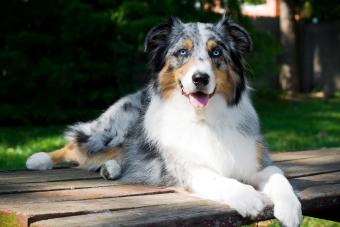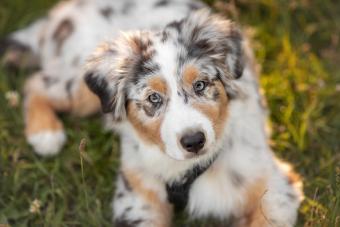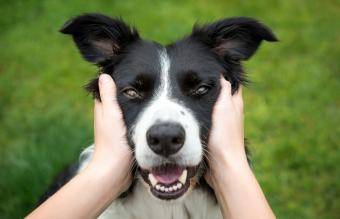
Don't let the Australian Shepherd's name fool you. This breed was actually developed in the United States. The Aussie is a medium-sized, high-energy dog most commonly associated with farm life. Their bright blue eyes, adorable personalities, and herding heritage make Australian Shepherds one of the smartest, most outgoing breeds you'll ever meet.
Australian Shepherd Quick Overview
- Personality: Energetic, intelligent, child-friendly
- Average weight: 40 to 65 pounds
- Average height: 18 to 23 inches
- Lifespan: 12 to 15 years
- Coat Length: Medium to medium-long
- Coat Colors: Blue merle, red merle, black, or red
- Hypoallergenic: No
- Group: Herding
- Origin: United States
Australian Shepherd Characteristics
The Australian Shepherd is an intelligent, active, and energetic dog breed with a strong desire to work. With the right training and socialization, this breed makes an excellent family companion. They are very friendly with other dogs and animals, but they do tend to have an independent nature and may be aloof with strangers until they get to know them better.
- Affection Level: Medium
- Friendliness: Medium
- Kid-Friendly: High
- Pet-Friendly: Medium
- Exercise Needs: High
- Playfulness: High
- Energy Level: High
- Trainability: High
- Intelligence: High
- Barking Level: Medium

Appearance
The Aussie, as the breed is affectionately referred to, is a sturdy dog of medium build that is highly energetic and keenly intelligent. They are able to observe a situation, reason out a course of action, and then go to it. These qualities are what make them superior in the field.
One very distinct characteristic of the breed is their bobbed tail, which is barely noticeable amongst the thick coat. This trait is recessive, and the preferred tail length for adult Aussies with docked tails is 4 inches, per the AKC standard.
Coat and Grooming
The Aussie carries a double coat that is medium in length, with a fluffier collar around the neck, shoulders and chest, sometimes referred as a "ruff." Coat colors include black, blue merle, red, and red merle. The breed sheds all year, but more profusely in the spring when they blow their winter coat. Aussies are not hypoallergenic.

To avoid matting, brush the Aussie's coat once a week, or more frequently during high shedding periods. Your Aussie should only require a bath when they're dirty, which shouldn't be more than a few times a year if you keep them brushed. To avoid drying out their skin and coat, make sure to use a dog-friendly shampoo product.
Temperament
The Australian Shepherd is a good-natured dog who can give the Energizer Bunny a run for his money, but it's only natural for them to be a bit reserved when meeting strangers. Aussies are extremely devoted to both their human family and their flocks, and will go to great lengths to watch over and protect both.
Aussies make fantastic, affectionate companions for families with children once they are socialized and trained properly. Aussies require special attention to socialization and exposure to a variety of people, sights, noises, and experiences, preferably while they're still young. If you find an adult Aussie, exposing them to new surroundings on a regular basis can assist them in becoming well-rounded adult dogs.
Because Australian Shepherds are herding dogs who consider children to be part of their "flock," you'll need to teach your dog that chasing and nipping at children in order to herd them isn't acceptable.
Exercise Requirements

The only real drawback to the Aussie personality - if it can truly be called a drawback - is their highly energetic nature and their need to burn off that energy. This means you need to give your dog plenty of exercise on a daily basis, or destructive behaviors may begin in an effort to keep them busy.
Every day, your Aussie needs at least some stimulating activity, such as a run, a Frisbee game, obedience exercises, or agility exercises. Interactive puzzle toys are a great way to keep their active mind occupied when you're not playing with them, providing both mental and physical stimulation.
Puppies don't require the same amount of vigorous activity as adults, and you shouldn't allow them to run on hard surfaces like concrete or leap until they're at least a year old. It could put a strain on their still-developing skeletal structure, leading to eventual joint issues.
Training
The mix of being sharp as a whip and eager to please is unbeatable. Aussies are relatively simple to train for almost any task, including housebreaking, farm work, and service work for the disabled. If you are prepared to put in the time with these dogs, they can genuinely become Jacks-of-all-Trades.
Reward-based training, also known as positive reinforcement training, has proven to be effective with Australian Shepherds. Instead of punishing the dog for undesirable behavior, this method of training encourages them to accomplish desired behaviors by rewarding them with praise or treats when they are well-behaved.
Australian Shepherds need a fenced yard or an experienced dog owner who will keep them busy at home with daily exercise and training.
Nutrition
As long as your Aussie is getting enough exercise, you shouldn't be concerned about obesity. However, it's still important to monitor their food intake and adjust accordingly based on their activity levels.
Dogs that are continuously exercising need more calories than dogs that go for a one-hour walk each day. This breed is also prone to allergies, so monitoring their feeding and adjusting with novel proteins or raw food options is often recommended for this dog breed. If you choose to go raw, you can pick what items to feed and what not to feed your dog. You can control every ingredient in your dog's food.
For most Australian Shepherds, feed 1½ to 2½ cups of dry dog food twice a day. If your dog is highly active, bump this up to roughly 2 to 3 cups, twice a day, and adjust based on your dog's weight.
Origin and History
The Australian Shepherd was designed to herd livestock for ranchers and farmers in the western United States, and many Australian Shepherds still perform this work today. The Aussie's origins likely include collie and shepherd-type dogs that were introduced with sheep shipments from Australia in the 1840s, leading to the name, "Australian Shepherd." Breeders aimed to improve their herding skills and create an adaptable, tireless, and intelligent dog.
Aussies were bred based on intelligence, temperament, agility, and herding instincts. Ultimately, the breed evolved into what is now considered one of the finest livestock-handling breeds in the world. Despite their popularity, the American Kennel Club did not recognize the breed until 1993.
Health Concerns
Like many dog breeds, the Australian Shepherd faces certain health problems.
Canine Hip Dysplasia is perhaps the most common ailment found in the breed today. Malformed joints lead to excessive wear on the cartilage, eventually resulting in bone rubbing on bone. This is very painful for affected dogs and can be crippling.
Additionally, Aussies may be prone to:
- Progressive Retinal Atrophy: A degenerative eye disease that results in the loss of photoreceptors at the back of the eye, eventually leading to blindness.
- Hypothyroidism: A condition in which the thyroid gland produces too little hormone.
- Cancer: Cancer can strike dogs just like it does humans. There are many distinct forms of cancer, and treatment efficacy varies from case to case. Surgery, medicinal treatments, and holistic treatments are all methods to manage or eradicate cancer. Aussies are most prone to developing hemangiosarcoma and lymphoma compared to other breeds.
- Canine Epilepsy: Epilepsy is a neurological condition that causes seizures. Epilepsy can be managed with medicine but not cured. With correct management of this inherited condition, a dog can live a long and healthy life.
- Skin problems: Australian Shepherds are prone to skin allergies, which are likely related to genetic causes. However, like with other dogs, their genes, upbringing, allergen exposure, and general exposure all play a role. Skin allergies may wreak havoc on your dog's skin if left untreated; prolonged itching can lead to hot spots or skin damage from repeated rubbing, scratching, and biting.
- Nasal Solar Dermatitis: This disorder, often known as Collie-nose, affects dogs with little or no pigment in their nose, though it is not limited to Collies. Lesions on the nose and occasionally around the eyelids form in dogs who are hypersensitive to sunlight, ranging from small pink lesions to ulcerating lesions.

Fun Facts About the Australian Shepherd
There's so much to know about the Aussie, you could study them your whole life and never learn it all. Here are just a few unique facts about the breed:
- Australian Shepherds weren't immediately well known. Following World War I, Australian shepherds had a major surge in popularity. As more people moved west, the athletic dogs found even more opportunities to shine as herding dogs.
- Aussie were ideal for the rodeo because they were intelligent and easy to train. That's where they gained the most attention.
- Because of their ghostly-blue eyes, Native American tribes dubbed the breed the ghost eye dog. They were believed to be sacred and were frequently avoided.
- The eyes of Australian Shepherds are not always blue; they might be green, amber, hazel, brown, or even two different hues. The dogs' eyes may be marbled, which means that each of their eyes is a blend of two or more hues.
- Hyper Hank, an Australian Shepherd, and his owner, Eldon McIntire, gained a lot of recognition in the 1970s for their amazing Frisbee routine. The brilliant disc team won competitions all over the country, performed at the Super Bowl XII pre-show, and spent time with the Carters at the White House.
Breeders and Rescues
Many people purchase Australian Shepherds without a clear idea of what it takes to own one. As a result, many Aussies are surrendered to shelters or rescues and are in need of adoption or fostering. If you don't find an Aussie rescue in your region, contact the national breed group or a local breed club, and they will be able to direct you to one. You can also take a look on PetFinder.com to find both purebred and Aussie mixes.
FAQs About the Australian Shepherd
The following are commonly asked questions about the Aussie breed:
- Are Aussies "Velcro dogs?" No, although they do love a good cuddle session, they can also be independent.
- Do Australian Shepherds bark a lot? Some Aussies are known for their tendency to bark, but you can train them not to bark.
- Do they get lonely? Yes, even though they aren't overwhelmingly clingy, they are prone to developing separation anxiety.
- Do Aussies get calmer? Yes, if you adopt an Aussie puppy, you can expect them to get calmer with age. However, you may not notice too much of a difference until about 2 years old.
- How hard is potty training? The Australian Shepherd is very intelligent and is eager-to-please. This combination makes them relatively simple to potty train.
- Do Aussies get along well with cats? Due to their high drive to herd, your Aussie may chase cats and other small animals. However, if they are raised with cats from a young age, they can become accustomed to them.
- Do they have any problems with hearing? Yes, some all-white Aussies may be hard of hearing because they lack pigment in their inner ear.

Australian Shepherd Pros and Cons
The following are pros and cons of this breed:
| Pros | Cons |
| Enjoy most activities with their family | Can become destructive if there isn't enough mental or physical stimulation |
| Easy to groom | Not hypoallergenic |
| Develops a strong bond | May develop a strong bond with one person rather than the family, depending on interaction |
| Protective of the family | Can be territorial |
| Suited for farm life or life with a family that enjoys activities | Not suitable for apartment-living |
Is the Australian Shepherd the Right Breed for You?
Australian Shepherds are devoted pets and tireless workers, but they might not be the ideal breed for everyone. An Aussie needs plenty of space to exercise, ideally with a lot of open yard to run and play. They also enjoy being useful and are never more fulfilled than when they have a task to do. After all, these are working dogs, so a cooped up life would likely be frustrating for both you and your dog.
Unless you are prepared to give as much devotion to your Aussie as they will shower on you, it might be better for you to consider a less active breed. An Aussie needs both challenges and socialization to thrive and remain happy. If you're searching for a smaller version of this breed, you may want to take a look at the Miniature American Shepherd, commonly referred to as the mini Aussie.







